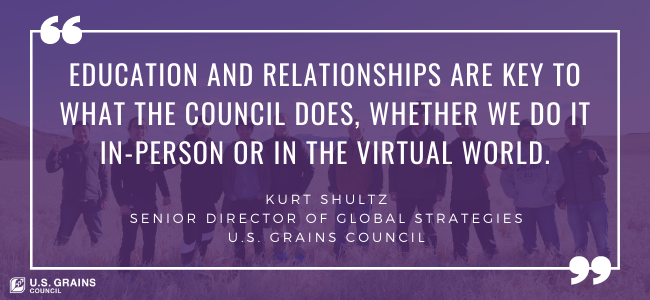Anyone who has participated in a U.S. Grains Council trade team knows how much work goes into pulling them off – and how rich the experience is for customers visiting the United States and their hosts in the U.S. countryside.
While tractor rides aren’t possible by webinar, the Council has learned in the past eight months of restricted travel due to COVID-19 that virtual trade teams can often reach a broader, more varied audience by requiring a shorter time commitment and far fewer travel logistics.
The virtual environment has allowed the Council to expand the breadth of its team participants across the whole value chain, including small, emerging grain buyers, large, established buyers and more individuals within target companies.
“Normally, in-person programs last a week and are planned around the needs of customers,” said Kurt Shultz, USGC senior director of global strategies, who also previously ran the Council’s offices in Tunisia and Panama. “However, now that trade teams are virtual, the Council can reach a wider, more diverse audience in a shorter amount of time without the customers having to leave the comfort of their offices.”
Traditionally trade teams are focused on the needs of a target audience, for instance technical teams focused on solving specific problems or purchasing teams looking to learn about the current U.S. crop and meet suppliers and exporters.
Members of technical teams often seek to learn more about nutrition, finance, biotechnology or other issues on which the Council will connect them with specialists and consultants. This interaction can still happen – and sometimes more quickly – through video conferencing.
In contrast, members of purchasing teams most want to see the product in the field and learn about U.S. farming practices. To meet this need, the Council has developed a series of virtual farm tours featuring U.S. producers who answer questions after a video presentation, including 19 trade teams that virtually visited U.S. corn and sorghum states after the Council’s Virtual Grain Exchange in October.
During an in-person program, the Council can only host so many participants, who are often the senior buyers from each company in a sector, country or region. However, the virtual world has allowed whole buyer teams to participate, in addition to experts across business functions. In some cases, senior executives who could not make the time to visit the United States in person have been able to attend virtual events.
“The trade teams hosted during VGE were tremendously successful and really highlighted the creativity and ingenuity of the Council’s members in adapting to this unique marketing challenge this year,” Shultz said. “Without a doubt, both the U.S. industry and our international customers took a huge leap forward this year in adapting to the virtual world.”
With hope on the horizon for resumed in-person travel in 2021, the Council is already thinking about how to integrate virtual tools into work with customers, including virtual trade teams to complement in-person events.
“The Council emphasizes building relationships with international customers and farmers,” Shultz said. “Now, it has adopted another tool we plan to keep in our toolbox. In the end, education and relationships are key to what the Council does, whether we do it in person or in the virtual world. Our international customers appreciate the investment the Council and our members make in their long-term growth and success.”

